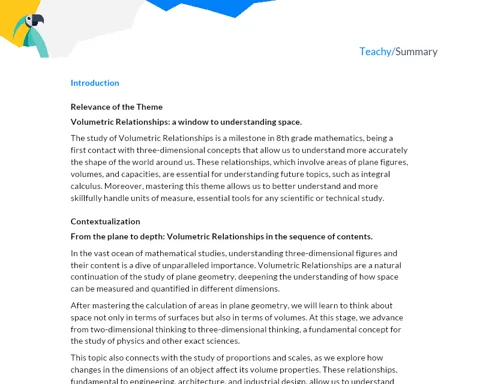Exploring Triangle Similarity in the Real World
Objectives
1. Recognize the necessary and sufficient conditions for two triangles to be similar.
2. Calculate measures of angles and corresponding sides in two distinct triangles.
Contextualization
Triangles are geometric figures present in various situations in our daily lives, from bridge architecture to art and design. Understanding triangle similarity is fundamental for solving practical problems, such as calculating inaccessible distances or creating accurate models. This knowledge is essential not only for mathematics but also for various professions and everyday activities. For example, in civil construction, engineers use similar triangles to design stable and safe structures, while architects apply them to create scale models of buildings and bridges.
Relevance of the Theme
In the current context, the similarity of triangles is crucial for various professional areas such as civil engineering, architecture, and graphic design. Understanding these concepts allows for the resolution of practical problems and innovation in different contexts, contributing to the development of skills that are highly valued in the job market.
Necessary and Sufficient Conditions for Triangle Similarity
For two triangles to be similar, it is necessary and sufficient that they satisfy one of the similarity criteria. This means they must have equal corresponding angles and proportional corresponding sides.
-
Two triangles are similar if their corresponding angles are equal.
-
Two triangles are similar if their corresponding sides are proportional.
-
The similarity of triangles can be verified by three criteria: AA (angle-angle), LAL (side-angle-side), and LLL (side-side-side).
Criteria for Triangle Similarity
There are three main criteria to determine if two triangles are similar: Angle-Angle (AA), Side-Angle-Side (LAL), and Side-Side-Side (LLL). These criteria help to quickly identify similarity without the need to measure all angles and sides.
-
AA Criterion: If two angles of one triangle are equal to two angles of another triangle, the triangles are similar.
-
LAL Criterion: If two sides of one triangle are proportional to two sides of another triangle and the angles formed by these sides are equal, the triangles are similar.
-
LLL Criterion: If all three sides of one triangle are proportional to the three sides of another triangle, the triangles are similar.
Calculating Measures in Similar Triangles
Once two triangles are established as similar, we can use the ratios between the corresponding sides to calculate unknown measures. This is especially useful in problems involving inaccessible distances or scale models.
-
Identify the corresponding sides of the similar triangles.
-
Write the proportion between the corresponding sides.
-
Solve the proportion to find the unknown measure.
Practical Applications
- Measuring Heights: Using the similarity of triangles, it is possible to measure the height of a building or tree without sophisticated equipment, just with a protractor and a simple theodolite.
- Architecture: Architects use similar triangles to create scale models of buildings and bridges, ensuring that proportions are maintained.
- Civil Engineering: Engineers apply triangle similarity when designing structures, such as bridges, to ensure stability and safety.
Key Terms
-
Triangle Similarity: Relationship between two triangles that have equal corresponding angles and proportional corresponding sides.
-
AA Criterion: Similarity criterion where two angles of one triangle are equal to two angles of another triangle.
-
LAL Criterion: Similarity criterion where two sides of one triangle are proportional to two sides of another triangle, and the angles formed by these sides are equal.
-
LLL Criterion: Similarity criterion where all three sides of one triangle are proportional to the three sides of another triangle.
-
Proportion: Mathematical relationship between two quantities that indicates how many times one quantity is contained in the other.
Questions
-
How can the similarity of triangles be applied in civil engineering and architecture projects to ensure construction accuracy?
-
In what ways do the criteria for triangle similarity facilitate solving problems involving inaccessible distances?
-
Think of a maker project you could develop using the concept of triangle similarity. How would this concept help solve practical problems in the project?
Conclusion
To Reflect
Triangle similarity is a fundamental concept in geometry that has significant practical applications in various professional areas such as engineering, architecture, and graphic design. Understanding the similarity criteria (AA, LAL, LLL) and knowing how to apply these concepts in real situations not only facilitates solving practical problems but also opens doors to technological and creative innovations. By reflecting on how we use triangle similarity in our daily lives, such as in measuring inaccessible heights or in construction projects, we realize the importance of this mathematical tool for creating effective and precise solutions.
Mini Challenge - Maker Challenge: Building and Using a Simple Theodolite
Build a simple theodolite and use it to measure the height of a tall object, such as a tree or a building.
- Gather the necessary materials: protractor, straws, tape, string, and weights (like paper clips).
- Attach a straw to the edge of the protractor using tape, so you can look through the straw and read the angle on the protractor.
- Attach a piece of string at the center of the protractor, with a weight at the end, to serve as a plumb line.
- Step outside the classroom and choose a tall object to measure.
- Look through the straw at the top of the object and read the angle on the protractor while keeping the plumb line aligned with the vertical.
- Record the measured angle and the distance from the observation point to the base of the object.
- Use the relationships of triangle similarity to calculate the height of the measured object.



